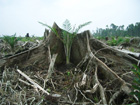 (Mongabay.com) There's a saying in the Indonesian palm oil industry: Sumatra is yesterday, Kalimantan is today, and Papua is tomorrow. Tomorrow might well have arrived. A new report sheds light on the industry's rapid expansion in Indonesia's easternmost region – and on the companies behind the plantation drive.
(Mongabay.com) There's a saying in the Indonesian palm oil industry: Sumatra is yesterday, Kalimantan is today, and Papua is tomorrow. Tomorrow might well have arrived. A new report sheds light on the industry's rapid expansion in Indonesia's easternmost region – and on the companies behind the plantation drive. Some are major conglomerates. Others are more opaque, with no website or company name at their listed address in Jakarta. The authors of the report – it was published by the Pusaka Foundation, awasMIFEE and six other organizations – found that staff at several of their offices refused to give out any information. Local government officials could also be difficult to reach and reluctant to cooperate. To inform their findings, the authors drew on Internet research and communication with local Papuan NGOs and church and indigenous organizations, as well as attempts to contact government and corporate sources.
The resulting West Papua Oil Palm Atlas portrays a frontier region's early encounters with a crop that has come to dominate the Sumatran and Bornean landscapes – a portrait made that much starker by the central government's foreign media blackout in the territory. "Using the excuse of the conflict around the [local] independence movement, the Indonesian government makes it very difficult for international observers to access West Papua, and this has probably also resulted in a lack of awareness internationally about the ecological threats," reads a text accompanying the report. The report's name refers to the entire western half of the island of New Guinea, a pair of Indonesian provinces where rebellion has simmered ever since Jakarta's invasion in the early 1960s.
Detailed maps by district grouping illustrate the extent to which oil palm is advancing in the region. In 2005, there were just five operational plantations, but by 2015 there were 21, with another 20 firms on the verge of obtaining their final permit and many more with an early-stage location permit. "If all these plantations were developed, more than 2.6 million hectares of land would be used up, the vast majority of which is currently tropical forest," the text reads.
Conglomerates with holdings in the region are led by some of Indonesia's richest men: billionaires Bachtiar Karim (Musim Mas), Sukanto Tanoto (Royal Golden Eagle), Eka Tjipta Widjaja (Sinar Mas), Anthony Salim (Salim Group) and Peter Sondakh (Rajawali).
Other major corporate groups include George Tahija's Austindo Nusantara Jaya, Arifin Pangioro's Medco, Malaysia-based Lion, Hong Kong-headquartered Noble and Sri Lanka-based Carson Cumberbatch.


